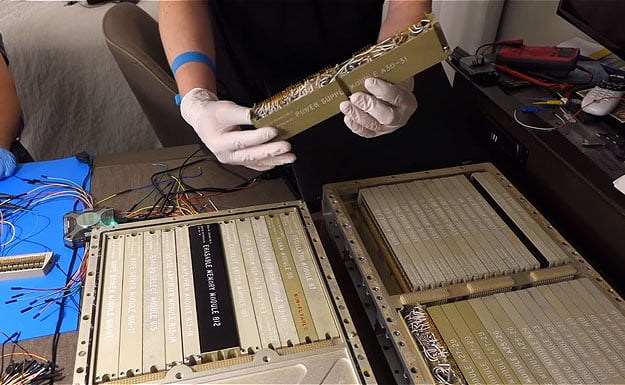NASA's Original Apollo Moon Landing Guidance Computer Is Being Restored

Restoration projects that focus on old computers that have long since been replaced by newer equipment always pique our interest, but this one is different. Mike Stewart, a "space engineer extraordinaire and living Apollo Guidance Computer (AGC) encyclopedia," is spearheading an effort to bring back to life arguably one of the most important computer systems ever built in US history.
That's not hyperbole, folks. As fellow restorer Carl Claunch explains in a running log on his blog, this a block II AGC, the kind that was used on all manned flights into space during its era. It played a critical role in the NASA Apollo program, helping to navigate space flights to the moon. With the exception of Apollo 8, each moon flight had two AGCs—one in the Command module and another in the Lunar Module.
"The Apollo Guidance Computer was fairly compact for a computer of its time. The CM housed the computer in a lower equipment bay, near the navigator's station. Block II measured 24 by 12.5 by 6 inches, weighed 70.1 pounds, and required 70 watts at 28 volts DC. The machine in the Lunar Module was identical," NASA explains.
This particular one was discovered by Jimmie Loocke, a former NASA contractor who performed thermal tests of the Apollo spacecraft at the Manned Spaceflight Center in Houston. His background helped him to recognize a pile of surplus NASA items while rummaging through a scrap metal recycler's warehouse, and lo and behold, there sat the ACG.
It is an incredible find, equaled by the effort to restore the intricate system. Even though it might be ancient by today's standards, there is a lot going on in the ACG, including a whole bunch of integrated circuits (ICs) that need testing and possibly repaired/replaced. There are quite a bit of schematics to trace as well—even tracking down the schematics represents an impressive effort by these restorers.
"In this first episode, we setup a makeshift lab in [Stewart's] hotel room, somewhere in Houston. The computer belongs to a delightful private collector, Jimmie Loocke, who has generously allowed us to dive in the guts of his precious machine, with the hope of restoring it to full functionality by July 2019, the anniversary of the Apollo 11 Moon Landing," the video's description reads.
The 21-minute video is definitely worth your time if you have even a passing interest in old technology, and/or the Apollo program. We're excited to see how it develops in future episodes.

